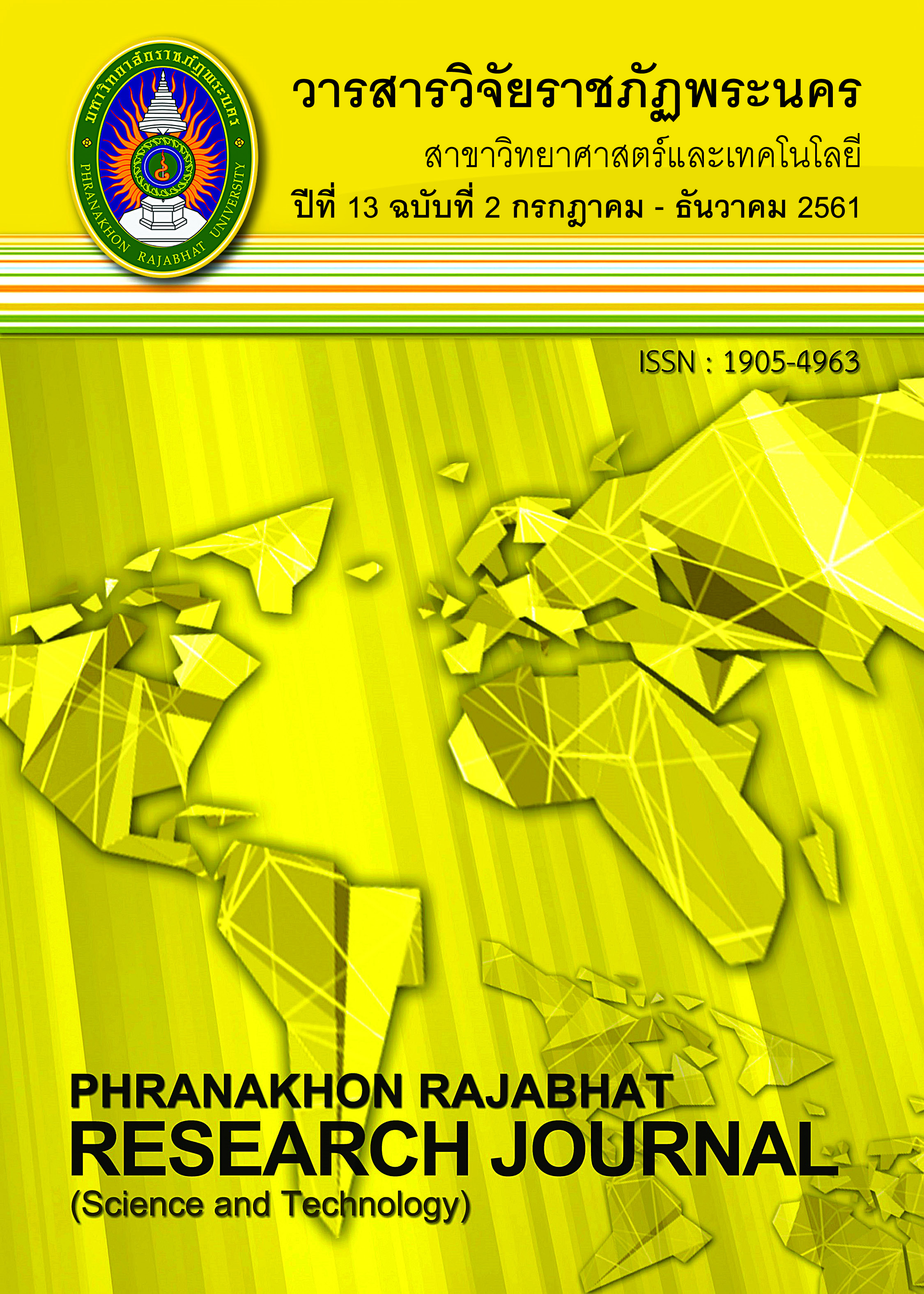UTILIZATION OF STARCH HYDROLYZED WASTE FROM SUGAR FACTORY FOR PRODUCING YEAST BIOMASS: OPTIMUM CONDITION AND KINETICS
Keywords:
Starch hydrolyzed waste, Yeast biomass, Saccharomyces cerevisiae, Aeration rate, Mathematical modelingAbstract
The aim of this research was to study the utilization of starch hydrolyzed waste (SHW) from glucose manufacturing as a raw material for producing yeast biomass Saccharomyces cerevisiae. Moreover, aeration rate of the yeast cultivation in fermenter scale was investigated. The result showed that total soluble solids, pH, and yeast extract affected to biomass production from SHW significantly. In addition, the quadratic equation for predicting the optimum condition was Biomass (g/L) = 2.38 + 0.36A + 1.13C - 0.021D + 0.052AC - 0.10AD - 0.042CD – 0.18A2 - 0.76C2 - 0.28D2. The optimum condition was total soluble solids, pH, and yeast extract for 16.73 °Brix, 4.84, and 8.78 g/L, respectively. Under this condition, the highest biomass was obtained for 2.95 g/L of shaking flask scale. Biomass production in 5-L fermenter demonstrated that the aeration rate influenced the biomass production. The maximum biomass and maximum biomass production rate at 1.0 vvm were higher than at 0.5 vvm for 10% and 75% approximately, respectively. Furthermore, experimental result denoted that the Logistic model and modified Gompertz model could simulate the growth of yeast in SHW as well.
References
Capozzi, V., Garofalo, C., Chiriatti, M. A., Grieco, F. & Spano, G. (2015). Microbial terroir and food innovation: The case of yeast biodiversity in wine. Microbiological Research. 181, 75–83.
Dodic, J. M., Vucurovic, D. G., Dodic, S. N., Grahovac, J. A., Popov, S. D. & Nedeljkovic, N. M. (2012). Kinetic modelling of batch ethanol production from sugar beet raw juice. Applied Energy. 99, 192–197.
Doran, P. M. (2013). Bioprocess engineering principles. 2nd edition. Amsterdam: Academic Press.
Fadel, M., Hassanein, N. M., Elshafei, M. M., Mostafa, A. H., Ahmed, M. A. & Khater, H. M. (2017). Biosorption of manganese from groundwater by biomass of Saccharomyces cerevisiae. Housing and Building National Research Center Journal. 13(1), 106–113.
Ferreira, I. M. P. L. V. O., Pinho, O., Vieira, E. & Tavarela, J. G. (2010). Brewer’s Saccharomyces yeast biomass:characteristics and potential applications.Trends in Food Science & Technology. 21(2), 77–84.
Hermansyah, H., Putri Wisman, A., Firdaus, D., Arbianti, R., Utami, T. & Kurnia, A. (2015). Effect of aeration and nutrients on Saccharomyces cerevisiae cultivation using lignocellulosic hydrolysate from empty fruit bunch. International Journal of Technology. 6, 1110.
Li, X., Ouyang, J., Xu, Y., Chen, M., Song, X., Yong, Q. & Yu, S. (2009). Optimization of culture conditions for production of yeast biomass using bamboo wastewater by response surface methodology. Bioresource Technology. 100(14), 3613–3617.
Li, Z., Wang, D. & Shi, Y. C. (2017). Effects of nitrogen source on ethanol production in very high gravity fermentation of corn starch. Journal of the Taiwan Institute of Chemical Engineers. 70(Supplement C), 229–235.
Limtong, S. (2006). Yeasts: Biodiversity and Biotechnology. Bangkok: KU Press. (in Thai)
Mathur, G., Mathur, A., Sharma, B. M. & Chauhan, R. S. (2013). Enhanced production of laccase from Coriolus sp. using Plackett–Burman design. Journal of Pharmacy Research. 6(1), 151–154.
Najafpour, G. D. (2015). Biochemical Engineering and Biotechnology. 2nd edition. Amsterdam: Elsevier.
Nuanpeng, S., Thanonkeo, S., Klanrit, P. & Thanonkeo, P. (2018). Ethanol production from sweet sorghum by Saccharomyces cerevisiae DBKKUY-53 immobilized on alginate-loofah matrices. Brazilian Journal of Microbiology, In Press.
Pilot Plant Development and Training Institute. (2003). Surveying and collecting data of water utilization and energy in tapioca starch factories. Thonburi: King Mongkut's University of Technology Thonburi. (in Thai)
Pinpimai, K., Rodkhum, C., Chansue, N., Katagiri, T., Maita, M. & Pirarat, N. (2015). The study on the candidate probiotic properties of encapsulated yeast, Saccharomyces cerevisiae JCM 7255, in Nile Tilapia (Oreochromis niloticus). Research in Veterinary Science. 102, 103–111.
Rajoka, M. I., Khan, S. H., Jabbar, M. A., Awan, M. S. & Hashmi, A. S. (2006). Kinetics of batch single cell protein production from rice polishings with Candida utilis in continuously aerated tank reactors. Bioresource Technology. 97(15), 1934–1941.
Taccari, M., Canonico, L., Comitini, F., Mannazzu, I. & Ciani, M. (2012). Screening of yeasts for growth on crude glycerol and optimization of biomass production. Bioresource Technology. 110(0), 488–495.
Trigueros, D. E. G., Fiorese, M. L., Kroumov, A. D., Hinterholz, C. L., Nadai, B. L. & Assunção, G. M. (2016). Medium optimization and kinetics modeling for the fermentation of hydrolyzed cheese whey permeate as a substrate for Saccharomyces cerevisiae var. boulardii. Biochemical Engineering Journal. 110, 71–83.
Veglio’, F. & Beolchini, F. (1997). Removal of metals by biosorption: a review. Hydrometallurgy, 44(3), 301–316.
Yen, H. W., & Liu, Y. X. (2014). Application of airlift bioreactor for the cultivation of aerobic oleaginous yeast Rhodotorula glutinis with different aeration rates. Journal of Bioscience and Bioengineering. 118(2), 195–198.
Zajšek, K. & Goršek, A. (2010). Modelling of batch kefir fermentation kinetics for ethanol production by mixed natural microflora. Food and Bioproducts Processing. 88(1), 55–60.
Zhou, J., Yu, X., Ding, C., Wang, Z., Zhou, Q., Pao, H. & Cai, W. (2011). Optimization of phenol degradation by Candida tropicalis Z-04 using Plackett-Burman design and response surface methodology. Journal of Environmental Sciences. 23(1), 22–30.
Zou, W., Han, R., Chen, Z., Shi, J. & Liu. (2006). Characterization and properties of manganese oxide coated zeolite as adsorbent for removal of Copper(II) and Lead(II) ions from solution. Journal of Chemical & Engineering Data. 51(2), 534–541.
Downloads
Published
Issue
Section
License
โปรดกรอกเอกสารและลงนาม "หนังสือรับรองให้ตีพิมพ์บทความในวารสารวิจัยมหาวิทยาลัยราชภัฏพระนคร สาขาวิทยาศาสตร์และเทคโนโลยี" ก่อนการตีพิมพ์




